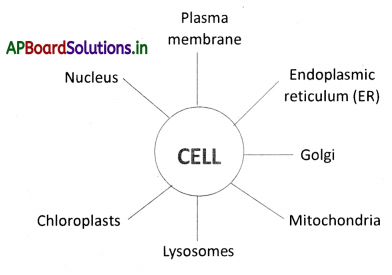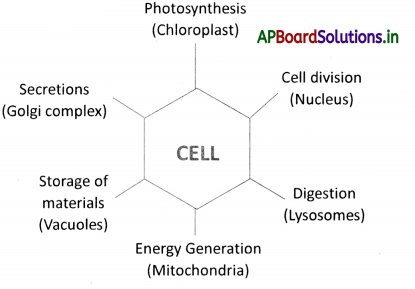Students can go through AP State Board 9th Class Biology Notes Chapter 1 Cell its Structure and Functions to understand and remember the concept easily.
AP State Board Syllabus 9th Class Biology Notes Chapter 1 Cell its Structure and Functions
→ We can see the cell wall cytoplasm, nucleus, chloroplast and mitochondria with \ a compound microscope.
→ Under the electron microscope, a few other structures became visible.
→ Chloroplasts occur only in the ceils of green plant parts like the leaf and tender I stem.
→ The fundamental organizational unit of life is the cell.
→ Cells are enclosed by a plasma membrane composed of lipids and proteins.
→ A plasma membrane is a selectively permeable membrane.
→ The plasma membrane defines the shape and size of the cell and protects from the exter¬nal environment
→ The cell wall is a tough, flexible porous layer.
→ During growth and development, the cell wall continuously exchanges information with other cells.
→ The plant cells can withstand much greater changes in surroundings medium than animal cells.
![]()
→ In-plant cells, a cell wall composed of cellulose is located outside the cell membrane. % Nucleus was named by Robert Brown in 1831.
→ The nucleus is the most important organelle of the cell
→ Schleiden called it the cytoblast
→ The nucleus regulates and controls all the functions and determines the characteris¬tics of the organism.
→ It is the bearer of genetic information and is closely involved in cell division.
→ Eucaryotic cells have a nucleus except for Red blood cells, phloem sieve tubes in plants.
→ The nuclear membrane separates the nucleus from the cytoplasm.
→ On the basis of the presence of nuclear membrane, cells are categorized into two types, i.e., Prokaryotic and Eucaryotic cells.
→ Prokaryotic cells nuclear membrane is absent e.g.: Bacteria, Cyanobacteria.
→ The cytoplasm is the fluid content, contains cell organelles.
→ In prokaryotes, membrane-bound cell organelles are also absent
![]()
→ Endoplasmic Reticulum transports the substances.
→ Two types:
- Rough Endoplasmic Reticulum (RER)
- Smooth Endoplasmic Reticulum (SER)
→ RER is the site of protein manufacture.
→ SER helps in the manufacture of fat molecules and lipids.
→ Invertebrate liver cells, SER plays a crucial role in detoxifying many poisons and drugs.
→ Camillo Golgi had observed Golgi body or Golgi apparatus in 1898.
→ It is made up of several membranes.
→ Its function is to package various substances.
→ The number of Golgi bodies is large in those cells that secrete hormones and enzymes.
→ Lysosomes contained destructive enzymes.
→ Lysosomes are also known as the suicidal bags of the cell « Mitochondria are also known as the powerhouse of the cell
→ They are small, spherical or cylindrical in shape and 150 times smaller than the nucleus.
→ It is made of a double-membrane wall
→ The inner wall protrudes and forms structures called cristae.
→ Plastids are of two types:
- Chromoplasts (coloured)
- Leucoplasts (colourless)
![]()
→ In Algae plastids are found as ladders, stars, spirals or reticulate.
→ Chloroplasts trap the energy of sunlight and transform it into chemical energy in photosynthesis.
→ The large empty spaces visible in the cells are vacuoles.
→ They are fluid-filled sacs i.e., storage sacs.
→ In mature plant cells, they might occupy almost the entire cell space.
→ All living beings are made of cells.
→ Matthias, Jakob Schleiden and Theodar Schwann together form cell theory.
→ Rudolf Carl Virchow (1855) first explained that new cells can be formed from the preexisting cells.
→ All living organisms are composed of cells and products of cell
→ All cells arise from pre-existing cells.
→ Plasma membrane: The outermost layer of the cell that separates cytoplasm from the external environment.
→ Selectively permeable: Plasma membrane allows certain substances to pass membrane through it hence membrane is called a selectively permeable membrane.
→ Cell wall: It is an extra layer outside the cell membrane in plant cells.
→ Prokaryotic cell: Cell that does not have a nuclear membrane-bound nuclear material or cell without a distinct nucleus.
![]()
→ Eukaryotic cell: Cell contains a membrane-bound nuclear material or cell with a distinct nucleus.
→ Chromo plants: These are the coloured plastids present ¡n only in plant cells.
→ Chlora plants: Chloroplasts are a type of plastids in green colour. They are of different shapes disc, oval, etc.
→ Leucoplasts: These are colourless plastids present only ¡n plant cells.
→ Cisternae: Enclosed spaces ¡n the cytoplasm of a cell, which gets separated from the ground substance by the cytoplasmic membrane.
→ Vesicles: Used for a cavity within the cytoplasm which is surrounded by a membrane.
→ Cristae: These are the folds of the inner membrane of mitochondria
→ Matrix: It is the space between cristae.
→ Unicellular: Organism made of a single cell.
→ Multicellular organism: Organism made up of many cells.
→ Cytoplasm: Used for the part of protoplasm excluding the nucleus.
→ Nucleus: It ¡s the control room of a cell having genetic information.
→ Mitochondria: Cell powerhouse and is a seat for cellular respiration.
→ Proteins: They are synthesized from amino acids and form one of the main constituents of protoplasm.
→ Cytoplasm: Schlelden called the nucleus a cytoplasm he thought that new cells were created from the nucleus.
![]()
→ Suicide bags: Lysosomes cause the destruction of cells hence they are called suicide bags.
→ Cellular respiration: Respiration taking place within the cell.
→ Succulent plants: A xerophyte that stores water in the tissue giving it a fleshy appearance.
→ Unique: Being the only one of its kind.
→ Specific: Detailed or exact.
→ Flexible: Able to change to new conditions or situations.
→ Hormone: An organic substance produced in small amounts at one site ¡n an organism and transported to another site where it acts.
→ Enzyme: An organic catalyst that catalyses a reaction within a cell.


→ Certain organelles are present in large numbers in the cell for example cells involved in photosynthesis may contain around 50 to 200 chloroplasts.
→ The Father of Cell Biology:
- Albert Claude is considered to be the father of cell biology.
- He was awarded the Nobel Prize for physiology medicine in 1974.
- Born in Belgium, he moved to the United States and worked at the Rockefeller Institute to develop cell fractionation and ultracentrifugation.